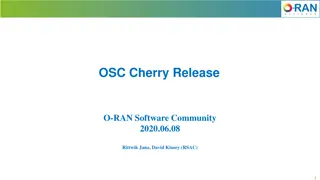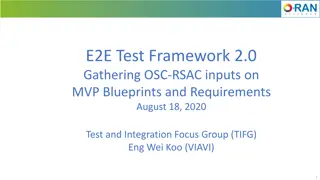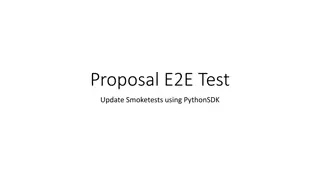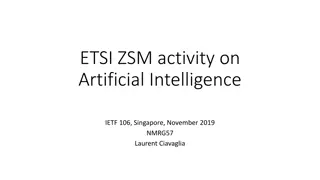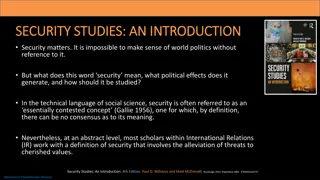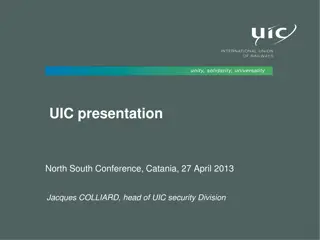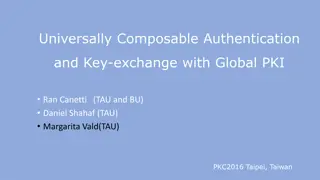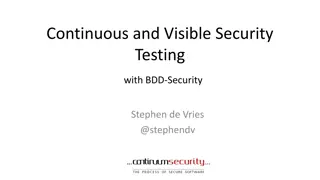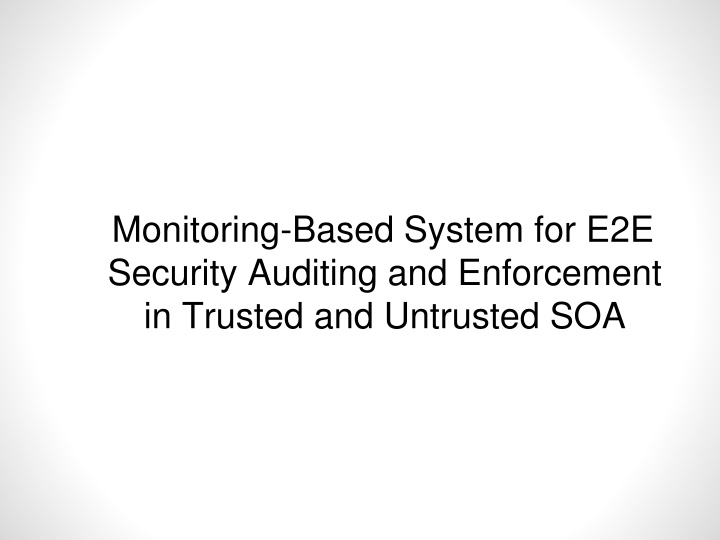
Enhancing Security in Service-Oriented Architectures with Monitoring-Based Auditing
Explore a novel approach for improving security in Service-Oriented Architectures (SOA) by monitoring service interactions, proactively handling potential threats, and enhancing data privacy. Learn about the benefits of this proposed research framework, including increased security, dynamic trust management, and agile defense mechanisms.
Download Presentation

Please find below an Image/Link to download the presentation.
The content on the website is provided AS IS for your information and personal use only. It may not be sold, licensed, or shared on other websites without obtaining consent from the author. If you encounter any issues during the download, it is possible that the publisher has removed the file from their server.
You are allowed to download the files provided on this website for personal or commercial use, subject to the condition that they are used lawfully. All files are the property of their respective owners.
The content on the website is provided AS IS for your information and personal use only. It may not be sold, licensed, or shared on other websites without obtaining consent from the author.
E N D
Presentation Transcript
Monitoring-Based System for E2E Security Auditing and Enforcement in Trusted and Untrusted SOA
Problem Domain: Typical SOA Scenario Potentially malicious Service B PII PII Service A PII Service C Service D Trust Domain Service Level Agreements / Security Policies Enforced PII: Personally identifying information Services may outsource part of their functionality to other services There is no control over the sharing of PII and service invocations outside the trust domain 1
Problem Statement A new threat landscape (large attack surface) Diverse security administration domains Security across organizational boundaries Any service may outsource part of its functionality to other services Chain of service invocations Service consumer only interacts only with the first service in the invocation chain Businesses place a lot of trust in their partners (trust is not transitive!) Consumer has no knowledge of or controlover the invoked services in the invocation chain Some of these services may be untrusted for the consumer User cannot specify the service invocation policies Violations and malicious activities in a trusted service domain remain undetected External services are not verified or validated dynamically (uninformed selection of services by user) Malicious activity may cause service disruptions 2
Benefits of Proposed Research This research proposes a novel method of dealing with security problems in SOA: Monitoring all interactions among services in the enterprise Provides increased awareness of security violations Proactive treatment of potentially malicious service invocations Leads to increased security Detection and prevention of service interaction anomalies Illegal service interactions Privacy preservation in service interactions Data leakage Dynamic trust management of services in an enterprise Enables timely detection of potentially compromised services Agile and resilient defense mechanisms Ability to adapt in the presence of anomalies The proposed service monitoring and auditing framework provides easy integration of any service topology, trust management method and authorization policy into a SOA system To enable global enforcement of security requirements in various runtime environments (including clouds) The proposed service monitoring techniques allow for easy detection of bottlenecks in an enterprise SOA Leading to increased performance 3
State of the Art Runtime auditing: Finite state automata to validate predefined interaction constraints [LJ06] Checking behavioral correctness of web service conversations [SG09] Reporting and monitoring functional requirements and QoS for BPEL processes [BG10] technology-dependent solutions Information flow control: Controlling leakage of data by sending/validating certificates in whole service invocation chain [SL10] inefficient, assumes service are semi-trusted AOP: Aspect-oriented extensions to WS-BPEL used to intercept execution of activities interacting with outside world [WH08] do not address security policy enforcement, are not generic Cloud and SOA auditing: Filtering and reasoning over audit trails to manifest potential security vulnerabilities based on compliance with established standards [XG12] compliance with standards does not imply security, needs strong support from cloud provider WS* standards and standard security protocols (HTTPS): point-to-point security (not end-to-end) 4
End-to-End Security Policy-Auditing and Enforcement in Service-Oriented Architecture System Architecture Service Monitor request Instrumentation Service 1 Passive Passive Listener Passive Monitoring Algorithms Active Active Listener Interaction Authorization Algorithms Trust Algorithms Algorithms Algorithms Trust Trust response request request (if authorized) Policies Service 2 All service interactions instrumented to go through passive or active listening Passive instrumentation logs interactions in the Service Monitor database Active instrumentation disallows invocations violating domain policies Trust values of services updated based on their invocations of other services 5
Methodology A novel service invocation monitoring and control mechanism Passive monitoring for service feedback Active monitoring for service interaction authorization A trust management system that manages dynamic trust of services Pluggable trust management algorithms that can be turned on/off at the system level A policy subsystem for policy definition, monitoring, and enforcement Pluggable service interaction authorization policies Management console to experiment with service interactions and evaluate different service topologies 6
ResultsOverview Low overhead of service instrumentation Experiments with: Baseline (no monitoring) Passive monitoring Active monitoring Implementation of different pluggable trust algorithms demonstrating protection capability of system under different conditions Moving average trust SORT (a Self-Organizing Trust Model for P2P Systems) Simulation of attacks showing system resilience DoS attack Insider attack Prototype capable of handling different interaction authorization policies 7
Active Service Monitoring Response Time Experiment Results Baseline Passive Active 17. Baseline Passive Active Run 1 10.11 11.48 24.35 12.75 Run 2 10.09 10.77 15.62 Run 3 10.20 10.13 13.65 8.5 Run 4 10.83 9.34 13.56 Run 5 9.52 10.92 13.57 4.25 0. Average roundtrip time per request (ms) LAN-based setup Testing based on Apache bench 50 concurrent requests per run Negligible overhead in Passive Monitoring Small overhead in Active Monitoring with 2 enabled policies Insignificant increase in overhead with more policies 8
DoSattack Attack creation: Simulated attack by introducing a delay in request processing at the service Attack detection: Client feedback trust algorithm deployed causes service trust value to decrease with weak feedback from clients due to increased delay Remedial action: Redirect requests to backup service 9
Insider attack Attack creation: Simulate insider to change transport protocol from HTTPS to HTTP Attack detection: Interaction authorization algorithm enforcing use of secure protocols Remedial action: Block request and interrupt service operation 10
Impact The conducted research provides a novel method of dealing with security problems in SOA. The main advantages of the solution are as follows: Monitors all interactions among services in the enterprise Provides increased awareness of security violations Proactive treatment of potentially malicious service invocations Dynamic trust management of services in an enterprise Enables timely detection of potentially compromised services Detection of bottlenecks in an enterprise SOA to improve performance Easy integration of any service topology, trust management algorithms and authorization policy into a SOA system Provides a platform to experiment with different service topologies and policies along with different perspectives of service trust evaluation 11
Demonstration Source code: https://code.google.com/p/end-to-end-soa/ Demo videos: 1. http://youtu.be/eJTT075rWQM : Typical SOA topology for online travel agent with examples for enabling trust modules/interaction authorization modules (4:00 min) 2. http://youtu.be/cbwfB0u9gfc: Mitigation of insider attack on the hotel service (2:21 min) 3. http://youtu.be/cEzy6frCX34: Use of XACML-based interaction authorization module to evaluate contents of a request and take actions (2:48 min) 12
Monitoring-Based System for E2E Security Auditing and Enforcement in Trusted and Untrusted SOA Focus: Security auditing and enforcement in trusted and untrusted environments (cloud) Data Privacy End-to-end privacy protection of data disseminated in a chain of service invocations Identity Management in trusted and untrusted environments Agile Defense Management Service monitoring Anomaly detection Automated situational awareness Resiliency and adaptability to failures and attacks Efficient dynamic service reconfiguration 13
Technical Approach Overview Service Monitor Active Bundle request Instrumentation Passive Service 1 Passive Listener Passive Monitoring Algorithms Active Active Listener Interaction Authorization Algorithms request (if authorized) Active Bundle Listener response request Heartbeat & Inflow Listener Policies Service 2 Dynamic Service Composition Anomaly Detection Trust reconfiguration Management 14
Proposed Solution Components Policies Passive Listener Active Listener Active Bundle Listener Heartbeat Module Authorize Log Trust React Analyze Management Agile Defense Detect Resiliency & Adaptability Anomaly Detection 15
Data Privacy PII Sharing in SOA 16 Services have access to all user information
Active Bundles for Data Privacy Message security mechanisms (HTTPS, WS-Security standards) are not sufficient Provide point to point security Unable to provide protection in remote domains Active Bundles Data-centric approach Encapsulation mechanism for protecting data Includes metadata (policies) used for controlled dissemination Access control policies Life duration Includes Virtual Machine (VM) Policy enforcement mechanism Protection mechanism Active Bundle operations Self-Integrity check Filtering Selective dissemination based on policies 17
Active Bundle Features Data-centric approach Self-monitoring ability Policy based access control Ability to control interactions Selective data dissemination Context-aware dissemination Minimal disclosure Interaction visibility 18 Ability to operate in unknown (untrusted) environment
User Request using Active Bundles Active Bundle order request + Credit Card request Active Bundle Payment Gateway Service E-commerce Service payment request + Credit Card authorization request Active Bundle Credit Card Authority Service 19
Active Bundle Message Exchange Service Domain AB AB Service Interceptor 20
Active Bundle Extraction and Execution Service Domain Message AB Service Interceptor AB 21 AB Process
Active Bundle-Service Interaction Service Domain Message AB Service Interceptor auth_challenge() auth_response() get_value() AB 22 AB Process
Active Bundles in SOA Service B AB AB Service A AB Service C Service D AB Trust Domain ABs expose an API to services: getSLA() authenticateChallenge() authenticateResponse(token, signedToken, serviceCert) getValue(sessionKey, dataKey) 23 AB API implemented using Apache Thrift AB is included in the message (REST/SOAP header)
Active Bundle Interaction with Service Monitor Active bundle logs state information with service monitor for each interaction: Authentication decisions Security policy evaluation results Self-integrity check results Information provided by active bundle is used by service monitor to: Evaluate trust for services with which active bundle interacted (dynamic trust management) Detect malicious service behavior (anomaly detection) 24
Active Bundle Security Challenges Data Security: Service interacting with AB may become anomalous Mitigation approaches: Use predicates over encrypted data and multi-party computing for authentication, authorization and identity management with AB Use threshold secret sharing scheme: Organize AB into separate items, assign encryption key and encrypt respective item using that key so that each service can access only items it s authorized for Use distributed hash tables (DHT) to store keys (to make practical attacks on key shares near-impossible) Execution Security: Service may alter AB code Mitigation approaches: Code obfuscation Polymorphic encryption code Placement of guard code to check for tampering [AN13] 25
DHT scheme for Active Bundles 26
Using DHT with Active Bundles Advantages: Huge scale - millions of geographically distributed nodes Decentralized individually owned nodes with no single point of trust Load reduction and Asynchronous communication no synchronization issues Hard to deduce all the shares (at least t) Hard to compromise all the nodes that store the shares Use continuous splitting to protect against dynamic adversaries (Zhou et al [30]) Improving DHT scheme: DHT loses key shares over time (nodes crash or leave) Republish the shares for availability Use a hybrid DHT (combination of reliable* DHT (openDHT in planet lab) and public DHT) Split K into K and K Split K into n shares and store in reliable DHT Split K into n shares and store in public DHT 27
Identity Management with Active Bundles Goals: Authenticate without disclosing identifying information Ability to securely use a service while on an untrusted host (VM on the cloud) Minimal disclosure and minimized risk of disclosure during communication between user and service provider Independence of Trusted Third Party 28
ID Management with AB: Anonymous Identification Use of Zero-knowledge proofing for user authentication without disclosing its identifier. User on Amazon Cloud ZKP Interactive Protocol User Request for service Function f and number k 1. E-mail 2. Password fk(E-mail, Password) = R Authenticated 1. E-mail 2. Password 29
ID Management with AB: Verification of Encrypted Data Verification without disclosing unencrypted identity data. Use ZKP or predicates over encrypted data Predicate Request* E-mail Password E(Name) E(Shipping Address) E(Billing Address) E(Credit Card) E(Name) E(E-mail) E(Password) E(Shipping Address) E(Billing Address) E(Credit Card) 30 *Age Verification Request *Credit Card Verification Request
ID Management with AB: Selective Disclosure User Policies in the Active Bundle dictate dissemination Selective disclosure* E-mail E(Name) E(Password) E(Shipping Address) E(Billing Address) E(Credit Card) 31 *e-bay shares the AB with the seller
Agile Defense Management Ability to reconfigure system service orchestrations to respond to anomalous service behavior Swiftly self-adapt to changes in context Automated situational awareness Ability to enforce proactive and reactive response policies to achieve system security goals Continuous system availability even under attacks Two components: Anomaly detection Remedial action (resiliency and adaptability) 32
Agile Defense Reacting All actions are successful Reaction actions are selected A service anomaly is detected Normal Anomalous Recovery actions are selected All actions are successful Recovery System agility states 33
Anomaly Detection Types of anomalies: Service behavior under abnormal conditions (service failures) Data usage anomalies (non-compliance with requester s data usage policies) Service interaction anomalies (unauthorized interactions) Insecure communication External attacks DDoS Injection attacks Internal attacks Service misconfiguration, e.g., exposing internal services to public Service misbehavior, e.g., anomalous external service communication 34
Anomaly Detection Process Develop anomaly signatures Analyze data continuously collected by service monitor: Service interaction data Identify malicious service behavior Incoming request data Identify internal/external attacks Service health data Identify threats such as DDoS attacks AB interaction logs Unauthorized data interactions, AB integrity violations 35
Resiliency and Adaptability Show resiliency against: data/service/authentication failures Adapt to changes in context [BB90] [BR89] Ability to remotely enforce security policies Using active bundles Ability to securely interact with services in untrusted domains Using active bundles Dynamic system reconfiguration Dynamic service composition Dynamically switching failed or compromised services to more reliable versions Service replication in cloud Dynamic trust evaluation Elastic auto-scaling Moving target defense 36
Determining Service Reliability Reliability of services can vary a lot in highly-dynamic environments Depending on the urgency of service requests, reliability may be traded off for performance Acceptability of a service for a specific service request: Meeting the minimum performance, accuracy and service composition requirements (QoS) Continuous acceptance testing can be used for up-to-date service reliability information to be logged by the trust management module Trust Manager Acceptance Test Service/Test input/ Acceptance test result 37 Acceptance test input Service output Service A
Dynamic Service Reconfiguration An SOA service orchestration is composed of a series of services that interact with each other based on a service interaction graph One of the multiple services in each service category can be selected for specific service functionality Challenge: Configuring set of services that conform to QoS and security policy requirements Dynamically reconfigured service composition is based on changes in the context with respect to timeliness and accuracy of information as well as the type, duration, extent of attacks and the complexity of the environment 38
Dynamic Service Composition and Reconfiguration Approach Goal: Maximize resiliency and trustworthiness of system by selecting the best individual services, while meeting security and SLA requirements Service monitor maintains up-to-date trust and QoS values for services Dynamic service composition/reconfiguration module will use information from service monitor database to find the most secure service composition given performance constraints NP-hard problem 39
Dynamic Service Composition and Reconfiguration Approach Formulate secure service composition as a variation of the Knapsack Problem: 40 We have developed heuristics-based algorithms to find near-optimal solutions to the problem
Dynamically Switching to More Reliable Services In case of service failure or detection of an anomalous runtime environment (under attack), services will need to be switched to more reliable versions dynamically Two approaches: Service replication in cloud: Have multiple replicas of the same service at different locations resiliency against service failure Live service migration to different runtime environment: To achieve live service migration, we plan to take advantage of VMWare s VSphere software Vsphere enables live migration of virtual machines between servers with no disruption of service 41
Moving Target Defense Static service domains/configurations are more prone to attacks than dynamic ones Advanced persistent threats (APTs) take advantage of static environments over a long period of time Periodic changes in service environment increases resiliency against attacks Approach: Periodically update service compositions Periodically update service configuration Periodically move services to different locations 42
Proposed Experiments Simulation of denial of service and distributed denial of service attacks Use the BackTrack tool to launch attacks against individual services and the service monitor Simulation of replay attacks Intercept active bundles to tamper with their code and retransmit to destination Simulation of system policy violations Introduce non-compliant services in various service compositions and for different types of policies including trust-based policies, data usage policies, data communication requirements etc. Simulation of attacks against data privacy Test active bundle mechanism by simulating violation of client s data sharing policies by services 43
Proposed Experiments (cont.) Performance of service invocations with vs. without active/passive monitoring Response time CPU usage Memory usage Stress tests to evaluate scalability of service monitor Cloud experiments: On industry standard platforms including Amazon EC2 Replication of services in the cloud Using different types of machine instances, operating systems and software packages Testing the effects of the auto-scaling capability in the case of high service demands 44
Success Criteria Resilience against service attacks Detection of system policy violations Resilience against data privacy violations Runtime performance of service monitor Service monitor scalability Effectiveness of dynamic service composition algorithm Successful deployment of monitoring framework on different platforms including industry-standard cloud infrastructures 45
References [AN13] P. Angin, Autonomous Agent-Based Mobile-Cloud Computing, Ph.D. Thesis, Purdue University, Dec. 2013. [BB90] B. Bhargava, S. Browne. ``Adaptable recovery Using Dynamic Quorum Assignments, in Proceedings of the Sixteenth International Conference on Very Large Data Bases (VLDB), Brisbane, Australia, August 1990. [BR89] B. Bhargava and J. Riedl. ``A Formal Model for Adaptable Systems for Transaction Processing, IEEE Transactions on Knowledge and Data Engineering, Vol. 4, No. 1, 1989, pp. 433-449. [BG10] L Baresi, S Guinea, O Nano, Comprehensive Monitoring of BPEL Processes, Proc. IEEE Internet Computing Conference, vol. 14(3), June 2010, pp. 50-57. [LJ06] Z. Li, Y. Jin, and J. Han A Runtime Monitoring and Validation Framework for Web Service Interactions, Proc. Australian Software Engineering Conference, Sydney, Australia, Apr. 2006, pp. 70 79. [SG09] J. Simmonds, Y. Gan, M. Chechik, S. Nejati, B. O'Farrell, E. Litani, J. Waterhouse, Runtime Monitoring of Web Service Conversations, IEEE Transactions on Service Computing, vol. 2(3), , 2009, pp. 223-244. [SL10] W. She, I. Yen, B. Thuraisingham, Enhancing Security Modeling for Web Services Using Delegation and Pass-On, Int. J. Web Service Res. vol. 7(1): 1-21 (2010). [WH08] G. Wu, J. Wei, T. Huang, Flexible Pattern Monitoring for WS-BPEL Through Stateful Aspect Extension, Proc. IEEE International Conference on Web Services (ICWS '08), Sept. 2008, Beijing, China, pp. 577 584. [XG12] R Xie, R Gamble, A Tiered Strategy for Auditing in the Cloud, Proc. IEEE 5th International Conference on Cloud Computing (CLOUD), June 2012, Honolulu, HI, pp. 945-946. 46









